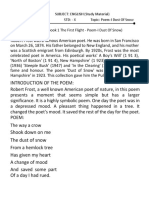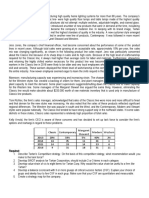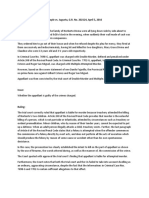Dust of Snow
Dust of Snow
Uploaded by
anandi1212199Copyright:
Available Formats
Dust of Snow
Dust of Snow
Uploaded by
anandi1212199Original Description:
Copyright
Available Formats
Share this document
Did you find this document useful?
Is this content inappropriate?
Copyright:
Available Formats
Dust of Snow
Dust of Snow
Uploaded by
anandi1212199Copyright:
Available Formats
Dust of Snow
Robert Frost
Summary
'Dust of Snow' by Robert Frost is a simple poem that throws light upon the healing power of
nature. The poet had been having a rough day and was regretting it but all of a sudden a crow
shook off the snow that had collected on a hemlock tree. The cold, white snow, which is often
associated with barrenness, caused the poet's mood to change. The dust of snow is a symbol of
tranquility that suits the poet's soul. The crow and the hemlock tree are often associated with
morbidity and evil; but the poet contradicts this belief by presenting these objects as carriers of
happiness. Thus, the poet conveys subtly through the poem that nature can be full of surprises.
1. What is a 'dust of snow'? How has it changed the poet's mood?
Ans. The poet, Robert Frost, has used this reference to talk about fine particles or flakes
of snow that are accidentally dusted off the hemlock tree only to land on the poet, and fill
his mind with peace.
The poet was experiencing a rough day that he regretted. While he was passing by the
hemlock tree, he was dejected and despondent. All of a sudden, a crow shook down the
dust of snow from the hemlock tree. As the snow touched the poet, there was an
immediate change of mood; he was filled with renewed energy and hope that led him to
look forward to the rest of the day that might have had something good in store for the
poet.
2. Comment on the use of symbolism in the poem.
Ans. In the poem, Robert Frost talks about the healing power of nature through
symbolism. The poet mentions three natural elements — snow, a hemlock tree, and a
crow, each of which is used as a symbol. These are used to represent three different
ideas. The hemlock tree and the crow are associated with evil and morbidity. Hemlock
tree is poisonous and a crow is believed to be an ominous creature. Snow, which
generally is witnessed during the winter, usually represents a picture of gloom and
barrenness. However, the poet contradicts these common beliefs and superstitions
associated with these three objects and talks of these as carriers of happiness and
hope. Initially, the poet was upset and was in despair but when the crow shook down the
snow from the hemlock tree that accidentally landed on the poet, it soothed his soul,
giving him hope and filling his mind with peace.
Reference to the context
Has given my heart
A change of mood
And saved some part
Of a day I rued.
a) What had helped in changing the speaker's mood?
Ans. The dust of snow had helped in changing the speaker's mood.
b) What other agents were involved in the act?
Ans. The crow and the hemlock tree were responsible for changing the speaker's mood,
along with the dust of snow.
c) Choose the correct option that describes the speaker's mood earlier.
1. Filled with regret and despair
2. Happy and excited
3. Relaxed and peaceful
4. Angry and agitated
Ans. Option 1
d) From the following,choose the correct literary device used in the poem.
1. Refrain
2. Alliteration
3. Symbolism
4. Simile
Ans. Option 3
e) Mention the rhyme scheme of the poem.
Ans. abab cdcd
You might also like
- Class 10 TH English ProjectDocument11 pagesClass 10 TH English ProjectGuru Srinivaas67% (6)
- Snow PoemDocument7 pagesSnow PoemVinod Kr100% (2)
- 253download. - 0POEM 1 CLASS X ENGLISHDocument4 pages253download. - 0POEM 1 CLASS X ENGLISHRemya SNo ratings yet
- Dust of Snow (Summary)Document8 pagesDust of Snow (Summary)Remya SNo ratings yet
- Dust of SnowDocument8 pagesDust of Snowgyanprasad309No ratings yet
- Poetry-Dust of Snow (Robert Frost) Lesson Explanation Stanza ExplanationDocument4 pagesPoetry-Dust of Snow (Robert Frost) Lesson Explanation Stanza ExplanationANANYA CHUGHNo ratings yet
- The Dust of Snow PDFDocument7 pagesThe Dust of Snow PDFtrevin79saiNo ratings yet
- KeytodustDocument5 pagesKeytodustathipharma.78No ratings yet
- Poetry-Dust of Snow (Robert Frost) Lesson Explanation Stanza ExplanationDocument4 pagesPoetry-Dust of Snow (Robert Frost) Lesson Explanation Stanza ExplanationANANYA CHUGHNo ratings yet
- Dust of Snow IntroductionDocument6 pagesDust of Snow IntroductionSelanMable100% (1)
- Dust of Snow: Robert Frost - A Short BiographyDocument8 pagesDust of Snow: Robert Frost - A Short BiographySantha KumarNo ratings yet
- Dust of Snow - FROST - FINALDocument7 pagesDust of Snow - FROST - FINALmanojboaNo ratings yet
- DUST OF SNOWDocument3 pagesDUST OF SNOWsalai.ashwinth.tisNo ratings yet
- X - Poem - 1 - Dust of Snow - NotesDocument6 pagesX - Poem - 1 - Dust of Snow - Noteskishan jhaNo ratings yet
- 1 1Document12 pages1 1jeets5781No ratings yet
- Dust of extra questionsDocument4 pagesDust of extra questionsnandusworld20No ratings yet
- Dust of SnowDocument13 pagesDust of Snowrauteladiya183No ratings yet
- Dustof SnowDocument2 pagesDustof Snowaaradhyawasthi38No ratings yet
- Dust of Snow Notes Class 10Document5 pagesDust of Snow Notes Class 10Sandhya DubeyNo ratings yet
- NYx GUZe STF 7 o 8 y KKD 2 AjDocument6 pagesNYx GUZe STF 7 o 8 y KKD 2 Ajabhinavjat15391No ratings yet
- Dust of SnowDocument12 pagesDust of SnowyogeshNo ratings yet
- DUST of SNOW_Q-ADocument2 pagesDUST of SNOW_Q-Aarmankaur239sherryNo ratings yet
- Dust of SnowDocument5 pagesDust of SnowGaurav SinghNo ratings yet
- 1.1 Dust of SnowDocument3 pages1.1 Dust of Snow9ghfx4gdc5No ratings yet
- C10_POEM_DUST_OF_SNOWDocument11 pagesC10_POEM_DUST_OF_SNOWbabita.rishav7099No ratings yet
- Poem 1 (Dust of Snow)Document4 pagesPoem 1 (Dust of Snow)sewenNo ratings yet
- Manisha Singh Work Duing Novel Corona VirusDocument7 pagesManisha Singh Work Duing Novel Corona VirusManisha SinghNo ratings yet
- Grade 10 Poem 1-Dust of SnowDocument2 pagesGrade 10 Poem 1-Dust of SnowVipin PatilNo ratings yet
- Dust of Snow Question and AnswerDocument4 pagesDust of Snow Question and AnswerAnushka TiwariNo ratings yet
- English 10th PoemDocument38 pagesEnglish 10th Poemgargminal93No ratings yet
- Bulletins-Buzf85cwnc1b-P1 Dust of Snow NotesDocument2 pagesBulletins-Buzf85cwnc1b-P1 Dust of Snow Notespinashah2102No ratings yet
- Dust of SnowDocument4 pagesDust of Snowaalia hasanNo ratings yet
- Dust of SnowDocument2 pagesDust of Snowakshaymonk45No ratings yet
- poemsDocument57 pagespoemssanubagade2022No ratings yet
- English Dust of Snow Class X: by Robert FrostDocument3 pagesEnglish Dust of Snow Class X: by Robert FrostManjunath CNo ratings yet
- DUST OF SNOWDocument12 pagesDUST OF SNOWvladmirbulubulu1No ratings yet
- Dust of Snow: by Robert FrostDocument8 pagesDust of Snow: by Robert Frosttusharpreet singhNo ratings yet
- Dust of Snow (Poem-1)Document2 pagesDust of Snow (Poem-1)Devi PrabaNo ratings yet
- Dust of Snow and Fire&iceDocument3 pagesDust of Snow and Fire&iceAndriya PaulNo ratings yet
- Dust of Snow CL-WPS OfficeDocument5 pagesDust of Snow CL-WPS Officecherry guptaNo ratings yet
- X_Dust of Snow and Fire & IceDocument8 pagesX_Dust of Snow and Fire & Icerekhadhakal41No ratings yet
- Dust of Snow: by RobertDocument8 pagesDust of Snow: by RobertSiddhant SharmaNo ratings yet
- Dust of SnowDocument6 pagesDust of SnowbihariNo ratings yet
- dust of snowDocument9 pagesdust of snowIEMS Ansuman Swain VIIIC 20No ratings yet
- Shiwali Kumari - Dust of Snow - 10'daffodils'-32Document10 pagesShiwali Kumari - Dust of Snow - 10'daffodils'-32shiwali689No ratings yet
- Poem-1 Dust of SnowDocument5 pagesPoem-1 Dust of Snownaitikgam75No ratings yet
- .TSD - X - CB - Eng - Dust of SnowDocument4 pages.TSD - X - CB - Eng - Dust of SnowXYZNo ratings yet
- Dust of Snow Extra QuestionsDocument3 pagesDust of Snow Extra Questionsmanan1.sushmaNo ratings yet
- Dust of SnowDocument17 pagesDust of SnowsharonNo ratings yet
- Question Bankdust of SnowDocument8 pagesQuestion Bankdust of SnowSaumit SurekaNo ratings yet
- Dust of Snow Question and AnswerDocument4 pagesDust of Snow Question and Answermaaman30102009No ratings yet
- 1332310-Dust of Snow - Class 10 Question BankDocument9 pages1332310-Dust of Snow - Class 10 Question Bankabhinavjat15391No ratings yet
- 9th EnglishDocument12 pages9th EnglishKavy PatelNo ratings yet
- e86f045bb9702c94a978a309b2472d70 (4)Document4 pagese86f045bb9702c94a978a309b2472d70 (4)aashrithags.schoolworkNo ratings yet
- Dust of Snow148Document9 pagesDust of Snow148Sradhanjali KarNo ratings yet
- English PoemsDocument24 pagesEnglish Poemsfactfinders31No ratings yet
- Dusts of Snow Fire N IceDocument3 pagesDusts of Snow Fire N IceMoonNo ratings yet
- unit 1Document2 pagesunit 1aathmikaramanathanNo ratings yet
- Design of Rectangular ColumnDocument7 pagesDesign of Rectangular ColumnJoshua NideaNo ratings yet
- FCB Rhodax4DDocument4 pagesFCB Rhodax4DGerardoNo ratings yet
- PVGTR 2004 18eDocument24 pagesPVGTR 2004 18esmackdooriNo ratings yet
- Unba Final Paper Uniform Civil Code Shreya Raulo Pranoy Goswami Nlu, AssamDocument15 pagesUnba Final Paper Uniform Civil Code Shreya Raulo Pranoy Goswami Nlu, AssamPRANOY GOSWAMINo ratings yet
- Commercialized 5-Star HotelDocument9 pagesCommercialized 5-Star HotelSAKET TYAGINo ratings yet
- Department of Education: Science 7Document5 pagesDepartment of Education: Science 7Maria Novy PintoNo ratings yet
- Kinematics of Linear Motion - NotesDocument2 pagesKinematics of Linear Motion - Notes莫真露No ratings yet
- 5 Technopreneurship A View of TechnologyDocument8 pages5 Technopreneurship A View of Technologyreyshielagustin100% (1)
- Tugas Akmen Lanjutan - TartanDocument2 pagesTugas Akmen Lanjutan - TartanmargaretaliwuNo ratings yet
- SURFCAM V5.2 System SummaryDocument17 pagesSURFCAM V5.2 System SummaryMohammadNo ratings yet
- L2 ThroughputDocument8 pagesL2 ThroughputyassminbgNo ratings yet
- Road Test SSR - 2020-21Document5 pagesRoad Test SSR - 2020-21Krushna LondheNo ratings yet
- Samcis - Ae212 - Module 7 Process Costing Lost UnitsDocument17 pagesSamcis - Ae212 - Module 7 Process Costing Lost UnitsMamaril John NathanielNo ratings yet
- Methods of Comparison of Alternatives and Decision Analysis: Chapter TwoDocument26 pagesMethods of Comparison of Alternatives and Decision Analysis: Chapter Tworobel popNo ratings yet
- 100 Ways To Say "I Love You"Document9 pages100 Ways To Say "I Love You"saiyedsultana7No ratings yet
- EWM Related Corrections Which Are Done Only by SAP 1682954196Document4 pagesEWM Related Corrections Which Are Done Only by SAP 1682954196kapilNo ratings yet
- Joint Danube Survey 3 PDFDocument369 pagesJoint Danube Survey 3 PDFdaniNo ratings yet
- II. Choose The Best Option To Complete The SentencesDocument3 pagesII. Choose The Best Option To Complete The SentencesNguyễn Phương DungNo ratings yet
- ArtsDocument18 pagesArtsSheila BenedictoNo ratings yet
- Design and Manufacture a Pressure Die Casting Tool for the Manufacturing of the Clutch Hub .Document6 pagesDesign and Manufacture a Pressure Die Casting Tool for the Manufacturing of the Clutch Hub .SMARTX BRAINSNo ratings yet
- Bargain Basement Bathysphere Test Dive Edition Free Demo PNP From WizKidsDocument4 pagesBargain Basement Bathysphere Test Dive Edition Free Demo PNP From WizKidsvopoloj239No ratings yet
- Personality DisordersDocument18 pagesPersonality DisordersSimón Ortiz LondoñoNo ratings yet
- His101 Final PDFDocument4 pagesHis101 Final PDFKhairul Basher SujonNo ratings yet
- Critical Thinking and GrammarDocument35 pagesCritical Thinking and Grammarappled.apNo ratings yet
- ElectrooculographyDocument23 pagesElectrooculographydrsrp84100% (2)
- Banco de Preguntas Parcial 1 InglesDocument54 pagesBanco de Preguntas Parcial 1 InglesJoel GuallichicoNo ratings yet
- Transtec 5 85W-140 MSDSDocument5 pagesTranstec 5 85W-140 MSDSstevanykurnia100% (1)
- Salar de UyuniDocument8 pagesSalar de UyuniSUHENDRI, S.PdNo ratings yet
- People vs. Jugueta, G.R. No. 202124, April 5, 2016Document1 pagePeople vs. Jugueta, G.R. No. 202124, April 5, 2016Mark Reyes100% (1)
- ReikiDocument33 pagesReikiSundar SNo ratings yet

























































































